
Ready, Set, Print
Family Industries shares what it takes to run a successful live screen printing business.
Published
4 years agoon
PERSONALIZATION, CUSTOMIZATION, THE “Amazon effect,” and social media are the major drivers for the screen printing industry, and frankly, most industries, today. Consumers want it how they want it, when they want it (right now), and it better be cool enough to post to their Instagram Story. How can you and your shop deliver on these four trends, you ask? For Family Industries (familyindustries.com) the answer is live screen printing.
The Los Angeles-based screen printing shop is known for live screen printing around the globe. They have the ability to print 7,000 shirts a day in their facility and have completed 3,500-plus live screen printing events since their inception in 2009. From a corporate business owner to a mom throwing a backyard birthday party, live screen printing has allowed the shop’s clients to personalize, customize, immediately own, and share the entire process on Facebook Live.
But before we get into that, let’s go back to the beginning.
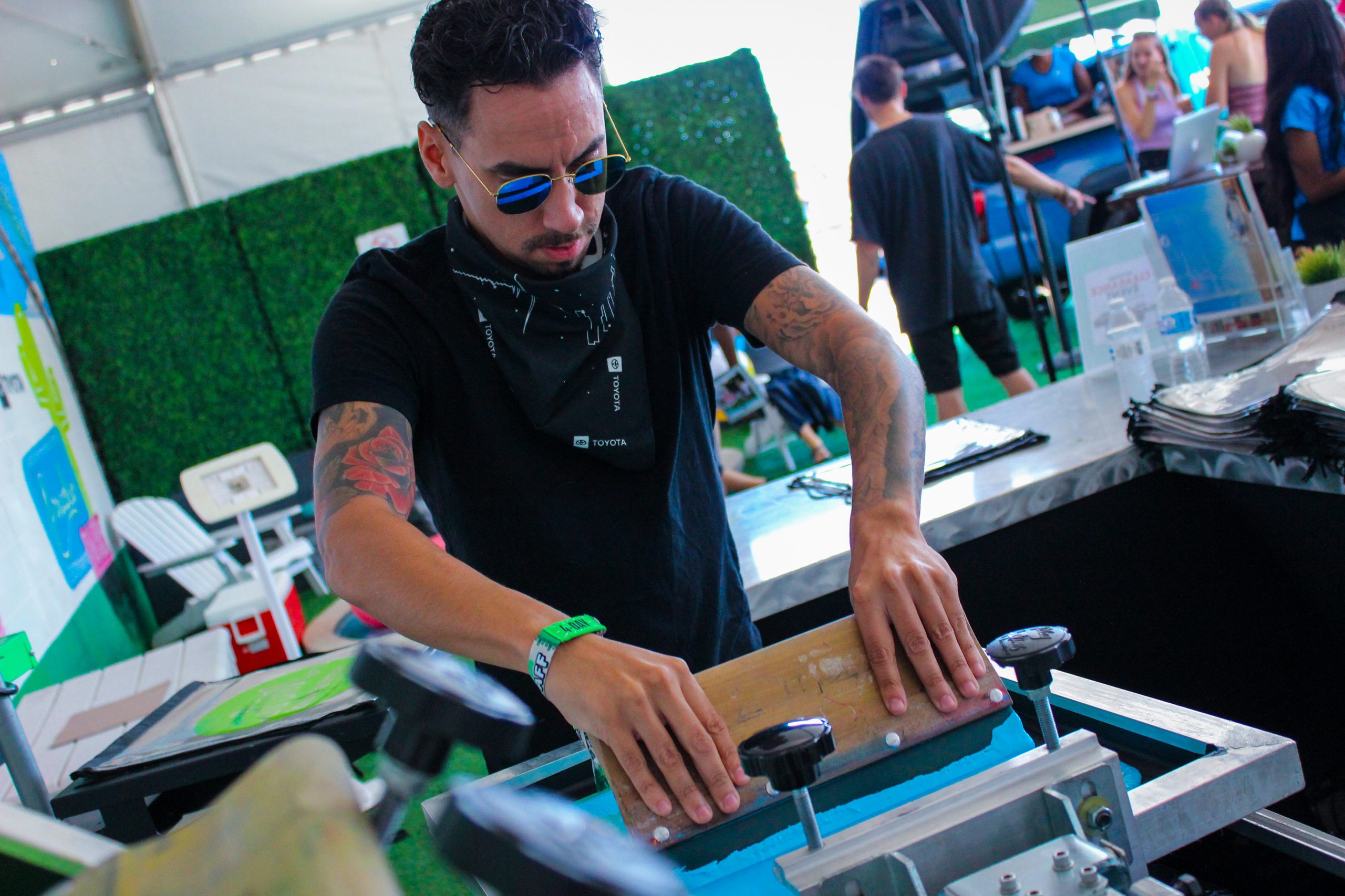
How It All Began
As many “how I became a screen printer” stories go, Max Hellmann – owner, business development and on-site activations, Family Industries – started printing shirts in high school for his band. After a hiatus, he found himself back in the screen printing mix when his LA roommate and downstairs neighbor were screen printing shirts for their friends. At the same time, he accepted a position at an experiential marketing agency. “Alex (Meiners), my now business partner at Family Industries, was working at a screen printing shop as a color separator in their art department,” says Hellmann. Meiners’ shop was in charge of printing for Ed Hardy, and Hellmann’s agency was screen printing for film and music festivals. “That turned into me helping put together all screen printing operations for a year-long Toyota Matrix event the agency was promoting in three regions across the US,” says Hellmann. “There were 900 event activations. They would open the back of the truck and there would be a giant screen for people to play video games and a screen printing kit next to it.” Hellmann and Meiners were able to preprint these shirts and make money on the side by selling them to the agency they were working for. This eventually gave the duo money to create Family Industries. “My boss soon realized I wasn’t paying attention to my actual work; I was focused more on the screen printing side, so he let me go,” says Hellmann. “He said, ‘You should go do this full time.’ So we created an LLC, it was nothing crazy. A week later, Alex’s company went under and he lost his job, so we decided to dive into the screen printing business head first.”
And just like that, the business became their full-time gig. Hellmann says having the connection to the music industry was helpful. They were able to keep Toyota as a client, which held 300 events a year and created opportunities for live printing at other events like Coachella.
Advertisement
Family Industries’ big break came from a tiny blurb in BizBash, a magazine covering the event industry. The article shared five cool things to do at your office party, one being live screen printing. “There was a tiny quarter of a page with our logo on a shirt,” says Hellmann. He and Meiners received 35 calls within three to four hours of the article being published. “And then it just took off.” Since then, they’ve never spent money on advertising because they garner clients through face-to-face relationships and attending events.
While the shop still completes small orders in-house, the live screen printing part of the business takes up 50 percent of their time; some months it climbs to 75 percent. They have 25 full-time employees, and the live team can range from five to 25 full-time or independent contractors for weekend events.
Family Industries touts their employees as professional screen printers and brand ambassadors. “Anyone can learn how to screen print and be great at, or even be OK at it, and still get business,” says Hellmann. It’s how they’re representing the shop and the client that matters. Family Industries’ employees must be able to communicate clearly with customers and guests onsite, have a very outgoing attitude, and explain the product they’re working with. “They actually know about the product at the event and why we’re promoting this specific product and can then direct the customer to a manager onsite,” he says.
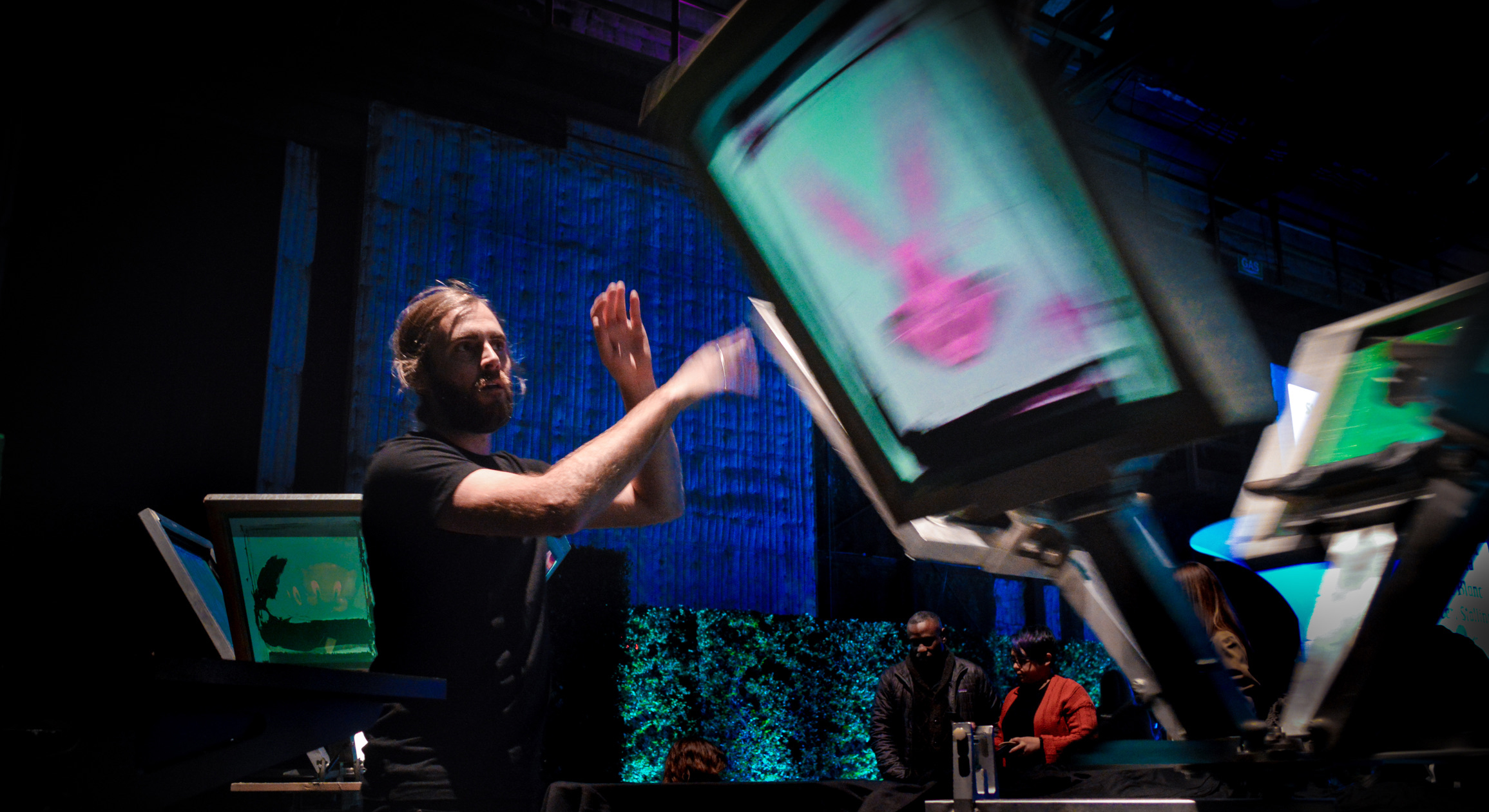
To make sure live printing is a success, Hellmann relies on his team. “There’s a couple of staff who will manage events and different roles in-house, like logistics and information about being onsite, loading time, live time, power drops, fitting in booth space, making sure we know if there’s a union onsite. …,” says Hellmann. “You’re dealing with Freeman Company [event logistics], booking travel, flights, getting equipment ready at the shop, making sure gear is properly equipped and up-to-date, checking inks. If we’re building a custom app, we have to test the app [yes, they offer an app] … there’s a lot you have to do before.” And then they have to travel onsite, set up and test, and work the event the next day. Plus, they ship their own gear. “Some shops use shops in different markets to cut costs, but we don’t want to risk the potential issues.” The team has built road cases for presses, and they ship them to different areas or transport them in a car or van if the event is local.
AdvertisementThere are a lot of perks with travel, says Hellmann – the team has been to Mexico City and the Dominican Republic, printed shirts at the bottom of a ski lift, and attended more music events than they count – but there’s a downside. “People get tired. There are big asks. Someone may fly from Orlando to New York City to Chicago back to Orlando just to start it all again,” he says. “It’s pretty demanding.”
Data and Action, On Demand
Live screen printing at an event is the draw, but Family Industries has to turn that into usable data for the client. “Toyota wants the data, mainly emails of potential buyers of the cars within their market segments. So, our team has to be able to accommodate that, specifically. We need to help Toyota achieve their goal,” says Hellmann. Prior to the event, the shop gets a rundown of the function and the product, a basic email is sent out ahead of time to the employees, and the staff then meets with the event company onsite.
So, about that app? Family Industries has a team they work with to create a custom app while using sublimation and sometimes heat transfers and screen printing at events. “People can design, drag, and drop different options, there’s personalization, they can create text in the app, and then print out thousands of different items for the client onsite,” says Hellmann. “It’s efficient. People aren’t waiting around for printing.” The team has 20 full screen tablets that host the app. “Agencies are more interested in full customization the last couple of years,” says Hellmann. “Screen printing is a really good way to increase booth traffic and visibility, but now people have seen it so they want the next thing.”
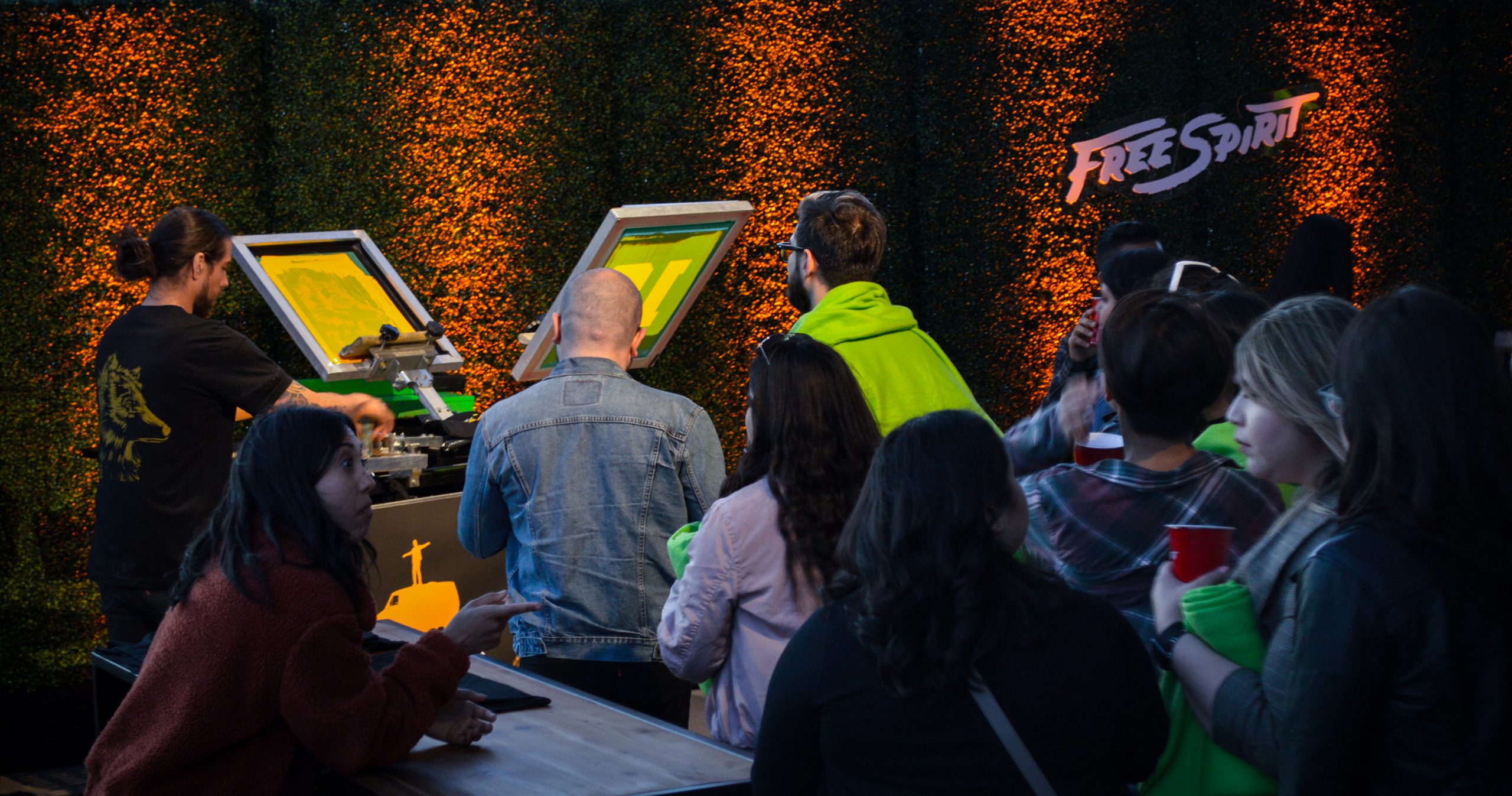
So, who is a typical client? From Bat Mitzvahs to veterinarian tradeshows, the list ranges far and wide. Agencies come to Family Industries for differentiation, sublimation, and any other type of embroidery or transfers. “There’s so much you can do onsite with customization,” says Hellmann. “They’re always asking for new things from us.”
Family Industries has a good base of existing clients, too. “Agency people move around all the time, so we keep relationships with them wherever they are,” says Hellmann. “It really matters who you’re working with directly and building relationships with the staff.”
AdvertisementThis list of printable items seems endless. Shirts, totes, mugs, laser engraved wallets, socks, hats, custom Adidas shoes, neck gators, oven mitts, trivets, bucket hats, hoodies, duffel bags, custom posters, pencil cases, lanyards, laptop sleeves, bandanas, notebooks, and smartphone cases are just a fraction of the selection. “Pretty much anything you can customize in a shop, you can print live,” Hellmann says.
What Not to Do
Hellmann and Meiners have now been involved with 3500-plus live screen printing events, but with any business there are lessons to learn along the way. At the duo’s first live event together, everything that could go wrong did.
Their first client was Hellmann’s previous employer, the marketing agency, and the event was a movie premiere for David Lynch. “It was a big-time event,” says Hellmann. “They had bands play, David did a Q&A, and we had screen printing onsite.” They brought in a basic setup with water-based ink, which Hellmann says is never recommended onsite. “It’s a huge mess. We had 12 people, which is way too many, but we didn’t know how it was going to work. We had heat guns to cure the water-based ink, which also doesn’t really work.” The screens locked up and they had to constantly clean them. “We didn’t know how to manage a line, so we had a giant swarm of people waiting, but it was still successful. People were still getting their stuff and learning about the process, and they’re mesmerized by how screen printing works plus getting the shirt.” Hellmann and Meiners learned from their mistakes. For example, they don’t use water-based inks anymore. “It took a while to get a setup we were comfortable using,” he says. Consultants can come in and set up your shop with workflow tips and tricks, but at the time, there wasn’t anything in place for live printing. “There’s no controlled environment, which is the biggest thing. You have to be flexible and quick to fix or see issues that may be arising,” Hellmann says.
That’s not all that’s gone wrong in the business’ 10-year history. “Things don’t show up, we’ve had to buy shirts an hour before the event starts because they didn’t arrive on time, we’ve had to deal with squeegees not being there, printers not working – you name it, it’s happened,” says Hellmann. “The key is having a plan in place in case something does go wrong. If you think something is going to happen, use your knowledge to fix it.”
Another mistake a live screen printing newbie can make is physically separating themselves from the customer. “People like talking and communicating with the printer,” Hellmann says. “They like to see what’s happening and why and how it works. It helps to create a connection, and it’s more memorable for that person,” he says.
Hellmann shares a story about when he got a call from a team at Stanford while he was finishing an event in Chicago. They realized 10 minutes before “go time” there weren’t any squeegees for Stanford’s graduation party so they couldn’t print the shirts. Their solution? The team fashioned squeegees out of cardboard. They made it work for one design. “You just have to eat the mistake at that point. Always check the kit! At some point you’re going to have to overnight something, drive something, and eat the costs. We try to do checklists, but with the way things move, things are going to happen.”
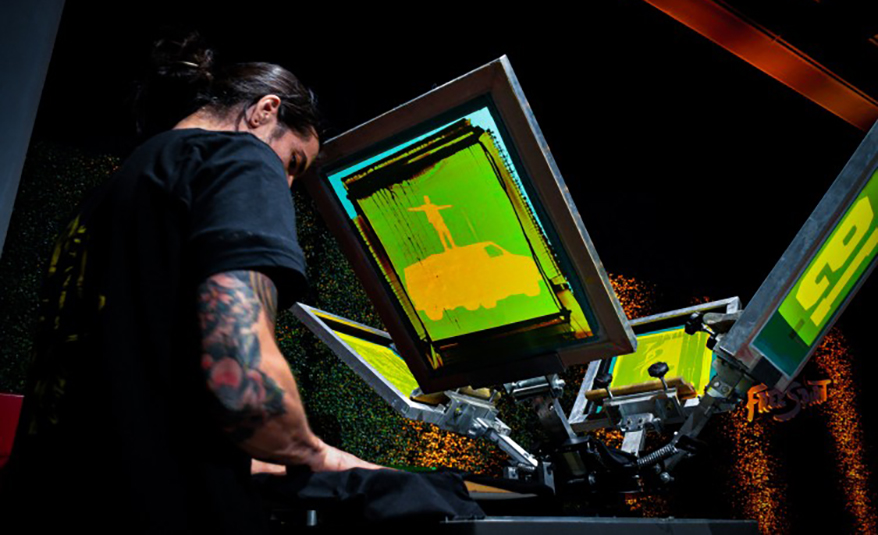
How to Do It
Hellmann suggests using your pre-existing network and gear you already own. He also says an in-house screen printing shop and an onsite team are completely different. “You’re not trying to replicate your shop. You’re trying to create the illusion you’re doing complex stuff, but keeping it simple onsite,” he says. “Always think of ways to be faster in terms of load in and load out.” Smaller gear and easier prints are the way to go.
“It may be good practice to deal with customers onsite, but you’re not going to guarantee your money back, so try to find sponsors of upcoming races or use clients you already have in your network and pitch the idea of live printing,” he says. If you’re printing 500 shirts for the local 5K, why not ask if you can print them onsite instead? You can charge more, garner more clients from face-to-face time, and practice. “Anywhere stuff is given out is an opportunity to live print,” says Hellmann.
Promo companies are their biggest competition. “They’re getting items to give out to customers, and live screen printing is the same thing: giving items to create brand awareness,” he says. “So instead of buying pens no one is going to use, offer onsite customization. People really like seeing whatever is printed happen in their face.”
Comic-Con is a perfect example of the excitement live printing brings. “People wait in line for stuff you would never wait in line for, but there’s a demand because it’s limited-edition.” Also, a line always draws a demand. Pro tip? “If you limit your shirts per day, it brings people back the next day,” he says.
Live screen printing does not have to be your shop’s full-time work. “We’ve seen a lot of companies come and go, but this is our core part of the business,” he says. “It depends on where you’re at with your business and how dedicated you are to making it work.” You can always use live screen printing as an add-on to help bring in additional income and more business.
“Everybody wants something immediately, so to be able to get something right away, there’s instant gratification that comes from it,” says Hellmann on why he thinks live screen printing has gained popularity. “People like experiences. Now people are bored with the norm, so having an experience is a selling point. You can get a shirt ahead of time – and they still have their place – but when you’re doing it onsite it draws people in. Plus, people love free stuff. There’s an insane reaction to both the screen printing and the free stuff.”
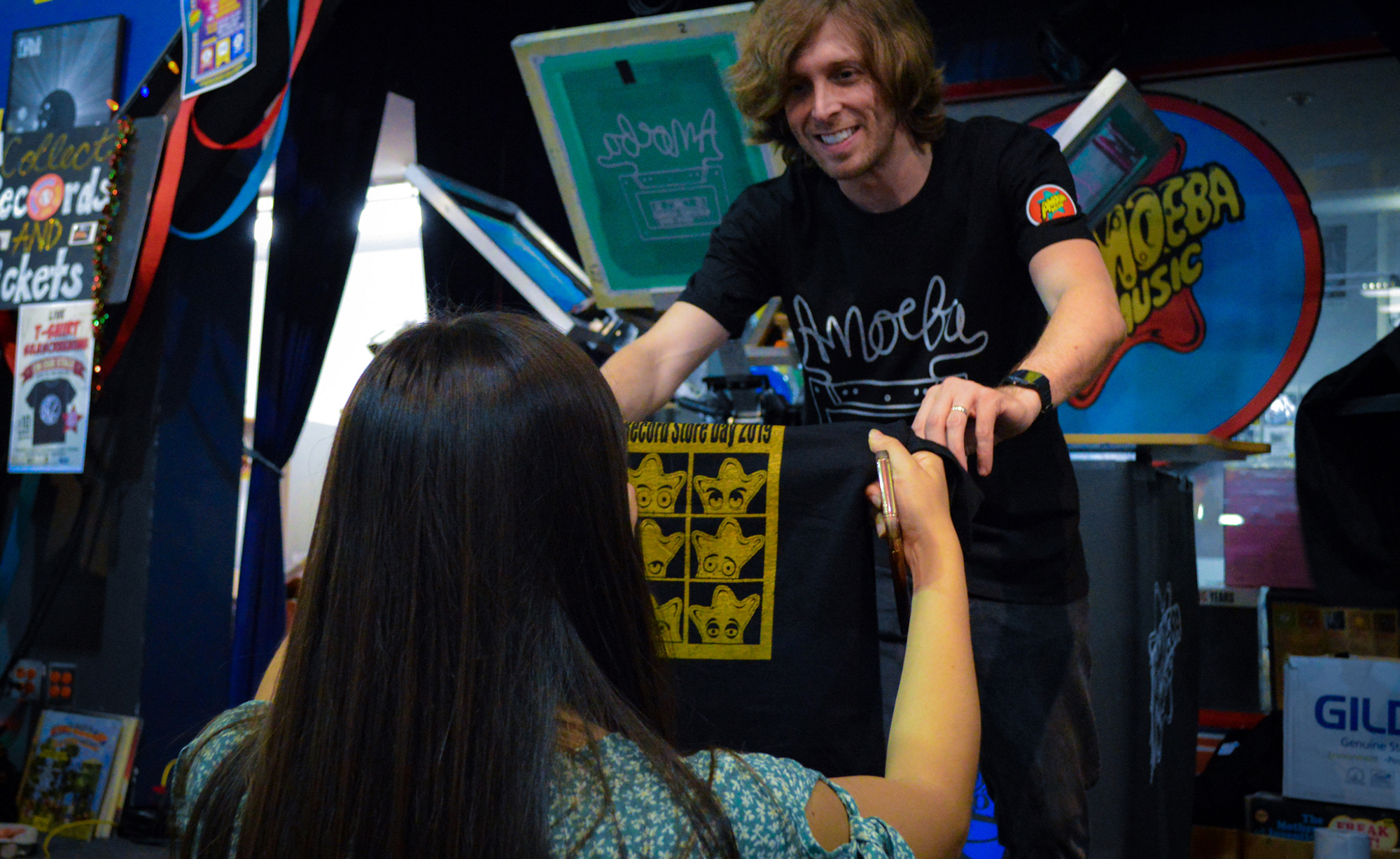
Family Industries defines success in three ways: if the client is happy, the guests are happy onsite, and no money has been lost. From their days of dual unemployment to running a global business, Hellmann and Meiners have also defined success for themselves.
Adrienne Palmer is the editor-in-chief of Big Picture and Screen Printing magazines. She joined Big Picture magazine in 2012 after graduating from Ohio University's E.W. Scripps School of Journalism with a BA in magazine journalism. During her time with Big Picture, she has held the roles of assistant editor, associate editor, and managing editor; she added sister publication Screen Printing magazine to her resume in 2019. She is a 2019 Folio: Top Woman in Media; spearheads Big Picture's annual Women in Wide Format Awards and Best of Wide Format Awards as well as Screen Printing's annual Women in Screen Printing Awards; is on the board of Printing United Alliance's Women in Print Alliance and the U.N.I.T.E. Together diversity and inclusion program; hosts the Screen Saver podcast; and represents the Big Picture and Screen Printing teams at numerous industry events year-round as a speaker, moderator, and panelist.

SPONSORED VIDEO
Let’s Talk About It
Creating a More Diverse and Inclusive Screen Printing Industry
LET’S TALK About It: Part 3 discusses how four screen printers have employed people with disabilities, why you should consider doing the same, the resources that are available, and more. Watch the live webinar, held August 16, moderated by Adrienne Palmer, editor-in-chief, Screen Printing magazine, with panelists Ali Banholzer, Amber Massey, Ryan Moor, and Jed Seifert. The multi-part series is hosted exclusively by ROQ.US and U.N.I.T.E Together. Let’s Talk About It: Part 1 focused on Black, female screen printers and can be watched here; Part 2 focused on the LGBTQ+ community and can be watched here.
You may like
Advertisement

Arcus Printers Barracuda Conveyor Flatbed Cutter

The Profit Impact of a Market Dominating Position

Inkcups Announces New CEO and Leadership Restructure
SUBSCRIBE

Bulletins
Get the most important news and business ideas from Screen Printing magazine's news bulletin.
Advertisement
Latest Feeds
Advertisement
Most Popular
-

 Case Studies2 months ago
Case Studies2 months agoHigh-Density Inks Help Specialty Printing Take Center Stage
-

 Art, Ad, or Alchemy2 months ago
Art, Ad, or Alchemy2 months agoF&I Printing Is Everywhere!
-

 Andy MacDougall2 months ago
Andy MacDougall2 months agoFunctional and Industrial Printing is EVERYWHERE!
-

 Columns3 weeks ago
Columns3 weeks ago8 Marketing Mistakes Not to Make When Promoting Your Screen Printing Services Online
-

 Editor's Note3 weeks ago
Editor's Note3 weeks agoLivin’ the High Life
-

 Marshall Atkinson3 weeks ago
Marshall Atkinson3 weeks agoHow to Create a Winning Culture in Your Screen-Printing Business
-

 Thomas Trimingham2 months ago
Thomas Trimingham2 months ago“Magic” Marketing for Screen Printing Shops
-

 News & Trends2 months ago
News & Trends2 months agoWhat Are ZALPHAS and How Can You Serve Them in Your Print Business?














